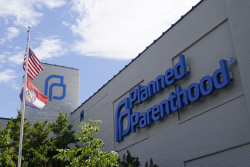
Lobbyists for rural hospitals should expect big bonuses this year. These hospitals receive only 1.3 percent of Medicaid spending and were largely exempt from cuts to the program in the One Big Beautiful Bill Act. But thanks to a new $50 billion grant program, these facilities might almost double their annual Medicaid revenues.
Medicaid generally provides between $1 and $3 in federal funds for every dollar that states spend on health care for low-income Americans. But states have found ways to inflate this return. Forty-nine states tax hospitals and other medical providers to increase the program’s cost, which raises the federal reimbursement for care. States have shared this windfall with hospitals as a kickback for participating in the scam. This practice led Congress in 1991 to limit state taxes on health-care providers to 6 percent of net patient revenues.
Finally, a reason to check your email.
Sign up for our free newsletter today.
The OBBB Act further reins in this practice by barring states from hiking provider taxes, even within the 6 percent limit. The law also embraces a proposal from President Obama’s 2013 budget to tighten the cap gradually on such taxes to 3.5 percent of patient revenues. This will slightly diminish Medicaid’s projected spending growth from $656 billion in 2025 to $941 billion (rather than $986 billion) in 2034.
The new law will also limit Medicaid fees for hospital services to Medicare rates, closing another loophole that had allowed states to claim extra funds by paying hospitals indirectly through private insurers. This move would mostly affect urban facilities, since Medicare specifically exempts most rural hospitals from its standard fees and pays them twice as much as it does non-rural hospitals.
With Republicans in control of Congress, Democrats, progressives, and advocacy groups have identified rural hospitals as a pressure point to stop these and other modest reforms. Senate Democrats claimed that without Medicaid funding generated by existing provider taxes, 338 rural hospitals would be at risk of closure. The New Republic warned that “Republicans’ Medicaid Cuts Could Cause a Rural Unemployment Crisis.” The American Hospital Association proclaimed that rural hospitals were “at risk,” and that “cuts to Medicaid would further threaten access” to care.
But rural hospitals constitute a small part of Medicaid, receiving only $12 billion of the program’s $880 billion annual spending. The Affordable Care Act increased total Medicaid spending by 51 percent, dwarfing the cuts enacted in OBBB. A study of the ACA’s Medicaid expansion found no significant improvement of rural hospitals’ profit margins, staffing, or patient outcomes as a result.
Legislators nevertheless are sensitive to lobbying pressure from hospitals, often the largest employers in their communities. Senators Susan Collins (R-ME) and Josh Hawley (R-MO) secured $50 billion in loosely defined grants for “Rural Health Transformation” from 2026 to 2030 to offset the $46 billion reduction in provider tax funding, scheduled to take effect by 2030. The $10 billion in new yearly grants would almost double the $12 billion in annual net revenues that rural hospitals receive from Medicaid.
As I note in my recent Manhattan Institute issue brief, rural hospitals are clearly under strain. Whereas urban facilities treat 102 inpatients per day, isolated rural hospitals see only two. But these facilities’ patient revenues are falling mostly because rural residents increasingly prefer to travel elsewhere for better treatment.
Hospital care involves substantial economies of scale, yielding better quality and lower costs in populated areas. High-volume hospitals use better equipment, deliver more appropriate treatment, obtain better surgical outcomes, see fewer complications, and achieve lower mortality rates. As one stakeholder said: “Do you want your gallbladder taken out in a place that does two of them a year?” Remarkably, rural hospital closures improve outcomes for obstetric care, as women shift childbirth to higher-quality facilities.
Still, maintaining access to emergency care in rural areas is important. Hospital closures can increase mortality associated with time-sensitive conditions, such as heart attacks or strokes. That’s why Congress in 2021 established Rural Emergency Hospital support payments. These give isolated rural hospitals $3.2 million each, annually, to maintain emergency departments regardless of other patient revenues. Yet only 36 of 1,569 eligible rural hospitals have so far opted to receive REH payments—suggesting that these facilities are in less financial trouble than lobbyists claim.
Democrats and lobbyists for big urban hospitals tried to hide behind rural providers to prevent cuts to Medicaid. They failed, but the pressure yielded a huge new slush fund for red state providers.
Photo: Althom / iStock Editorial / Getty Images Plus
City Journal is a publication of the Manhattan Institute for Policy Research (MI), a leading free-market think tank. Are you interested in supporting the magazine? As a 501(c)(3) nonprofit, donations in support of MI and City Journal are fully tax-deductible as provided by law (EIN #13-2912529).
Source link
















